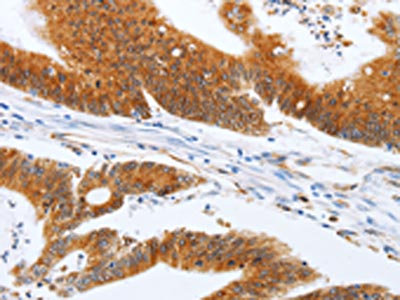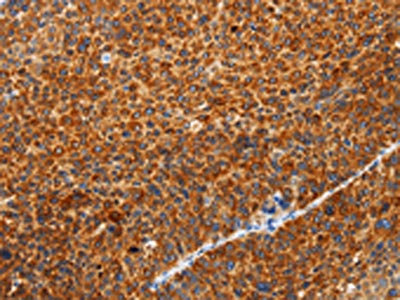
The image on the left is immunohistochemistry of paraffin-embedded Human colon cancer tissue using CSB-PA559431(SPATA13 Antibody) at dilution 1/20, on the right is treated with fusion protein. (Original magnification: x200)
SPATA13 Antibody
CSB-PA559431
ApplicationsWestern Blot, ELISA, ImmunoHistoChemistry
Product group Antibodies
ReactivityHuman, Mouse
TargetSPATA13
Overview
- SupplierCusabio
- Product NameSPATA13 Antibody
- Delivery Days Customer20
- ApplicationsWestern Blot, ELISA, ImmunoHistoChemistry
- CertificationResearch Use Only
- ClonalityPolyclonal
- ConjugateUnconjugated
- Gene ID221178
- Target nameSPATA13
- Target descriptionspermatogenesis associated 13
- Target synonymsARHGEF29, ASEF2, spermatogenesis-associated protein 13, APC-stimulated guanine nucleotide exchange factor 2, adenomatous polyposis coli stimulated exchange factor 2
- HostRabbit
- IsotypeIgG
- Protein IDQ96N96
- Protein NameSpermatogenesis-associated protein 13
- Scientific DescriptionActs as guanine nucleotide exchange factor (GEF) for RHOA, RAC1 and CDC42 GTPases. Regulates cell migration and adhesion assembly and disassembly through a RAC1, PI3K, RHOA and AKT1-dependent mechanism. Increases both RAC1 and CDC42 activity, but decreases the amount of active RHOA. Required for MMP9 up-regulation via the JNK signaling pathway in colorectal tumor cells. Involved in tumor angiogenesis and may play a role in intestinal adenoma formation and tumor progression. Both the ABR and the SH3 domains contribute to maintaining the protein in an inhibited conformation by associating with the C-terminal tail. Binding of these domains to the C-terminal tail inhibits the activity of the protein by blocking a region that is required for its GEF activity.
- ReactivityHuman, Mouse
- Storage Instruction-20°C or -80°C
- UNSPSC41116161





